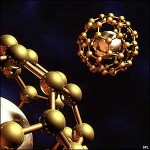 – I’ve been concerned about nanotechnology for sometime ( ➡, ➡, and ➡).  It’s not that I don’t like the idea and don’t think it has a lot of future. I read The Engines of Creation way back in 1988 and was deeply impressed by the promise of it all.
– I’ve been concerned about nanotechnology for sometime ( ➡, ➡, and ➡).  It’s not that I don’t like the idea and don’t think it has a lot of future. I read The Engines of Creation way back in 1988 and was deeply impressed by the promise of it all.
– My concerns are, rather, the way we’re going about it.  As always, humanity, in its impatience for maximum profit in the minimum time, is developing and dispersing these agents into our environment with no real idea of the possible consequences.  Just like all the industrial chemicals we’ve developed and employed in the past, we’re assuming these materials will not cause any problems – a least until we find out otherwise.
– I also read Kurt Vonnegut’s Cat’s Cradle many years ago and if you haven’t heard the story of ICE-9, you should.
* – – – – – – – – – – – – – – – – – – – – – – – *
Scientists try to clean up nanotechnology before it becomes a big business–and a big problem
Nanotechnology‘s image is sleek, modern and clean. But that’s not its reality.
Turns out that designing and manufacturing materials so small that 100,000 of them can fit comfortably on the width of a hair strand absorbs tremendous amounts of energy and is anything but neat.
“You can make a very green product with a very messy process,” said Mark Greenwood, a Washington lawyer and former director of U.S. EPA’s Office of Pollution Prevention and Toxics.
That “very messy process” is a problem for nanotech researchers trying, among other things, to design more efficient batteries, higher-performing solar cells, more effective water purifiers and more sensitive pollution detectors.
Consider what it takes to purify a nanomaterial of unwanted chemicals. Traditionally, that has required the repeated use of solvents – a lot of them, said James Hutchison, a professor at the University of Oregon.
“If you’re washing with a solvent, you’re wasting a lot of solvent,” Hutchison said. “This is the biggest contribution to waste we’ve been able to see. If you think about a lifecycle analysis on this, you see what’s the hot spot, and think about other ways to purify that don’t require solvent.”
Hutchison and others are trying to come at the nanotech problem with “green chemistry” techniques that emphasize materials, products and processes that reduce or eliminate hazardous substances and conserve energy and resources. His solution for the solvent waste: a nanofiltration membrane that separates nanomaterials from the rest.
Hutchison’s work is part of a larger University of Oregon effort that researchers call green nanoscience. In 2005, Hutchison launched the Safer Nanomaterials and Nanomanufacturing Initiative, which is funded by the Air Force and aims to develop nanotechnology to ensure high performance without threatening human health or the environment.
Because nanotechnology is still an emerging field, scientists believe there are opportunities to make it environmentally safe. “Now’s the time to think about how to make this stuff clean and green,” said David Rejeski, director of the Woodrow Wilson Center’s Project on Emerging Nanotechnologies.
But the technology is steaming ahead, and the opportunity is unlikely to last long.
More… ➡
Tags: nanotechnology